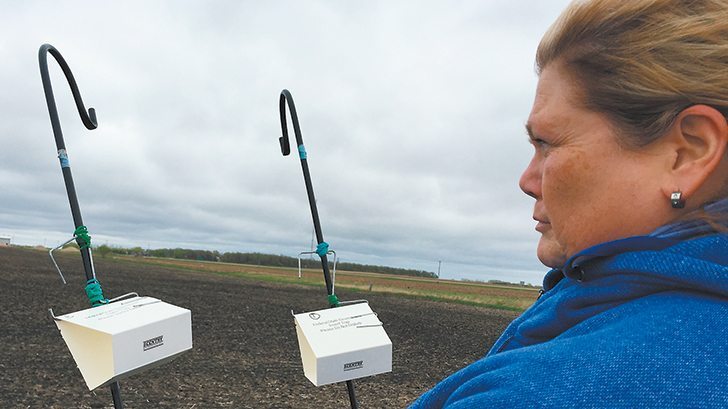MORRIS, Man. — Ingrid Kristjanson stands in a howling, north wind, maintaining the thin sticky line that alerts farmers when insect hordes are crossing the frontier.
The field is cold and it’s only early May, but already an emerging canola crop is peaking above the surface, reaching for the sun and vulnerable to the bugs.
Kristjanson, a Manitoba agriculture specialist, is one of hundreds of agronomists and crop management advisers who place, monitor and report on bug traps across Western Canada.
They are an early warning system designed to be simple to employ, easy to maintain and able to produce information that can save farmers hundreds of millions of dollars.
Read Also

Agritechnica Day 2: The future of tractor power, building quicker crop apps and large farms and tech
Agritechnica Day 2: The future of tractor power, building quicker crop apps with Syngenta and large farms and tech
Catching an incipient bug infestation early can save a crop and prevent a farmer’s work going to waste.
The bug traps are simple, crude devices by design. They need to survive a wide range of prairie conditions and be used by many people with little training or scientific skill. Entomologists are few and far between on the Prairies.
The ones Kristjanson is installing on this day are made from a short, hooked metal pole, a triangular moth trap with a glue sheet and a tab of pheromone, and tough wire to keep the trap on the pole in the harshest prairie winds and hailstorms.
These particular traps are being used as a trip wire for Swede midge, a canola pest common in Ontario and the western Prairies. It is not yet present in eastern Manitoba, and the best result for these traps will be to find none at all.
The midge is tiny, so Kristjanson won’t try to interpret the trap counts when bugs start getting stuck.
“Rather than misidentify, we send them off (to a lab),” she said.
For Swede midge, that means Saskatoon, where Agriculture Canada operates a Western Canada-wide monitoring program. Kristjanson will come back to these two traps once a week, remove the glue sheets and send them away.
On the opposite side of the field is an already standing diamondback moth trap. It’s cold and little is growing yet in the area, but more than a dozen bugs are stuck there when Kristjanson pulls out the glue sheet.
Six of them appear to be diamondback moths, which means the tripwire has been pulled and she has something to report.
The diamondback moth doesn’t overwinter in Manitoba, where it is too cold. It arrives by wind from the United States, its tiny weight and gossamer wings allowing it to be blown wherever the wind takes it, which includes the fields of western Canadian farmers.
Kristjanson doesn’t read too much into the appearance of the six moths here.
“It doesn’t give you a population for that field, just an idea of what’s in the region,” she said, examining the grid of stuck bugs.
However, crop management experts can use the results of similar traps in this area, across southern Manitoba and across the Prairies to build maps of hot spots and bug-free areas.
It’s an age of GPS monitoring, satellite surveillance of vegetation and a plethora of big data computational systems, but sometimes simple and crude structures like the thin sticky line of bug traps across the Prairies still works best. It’s not something likely to soon disappear from western Canadian fields.
















